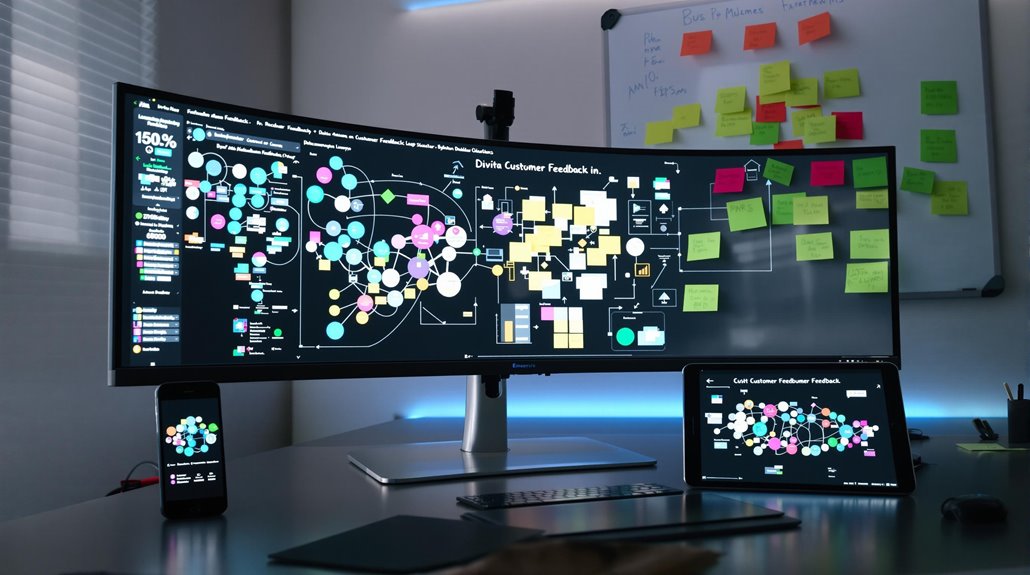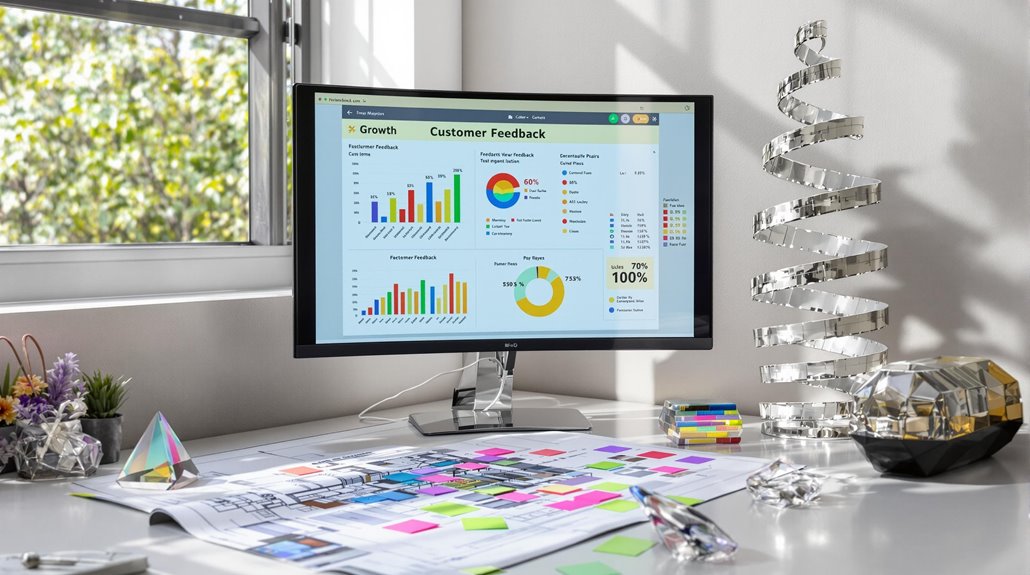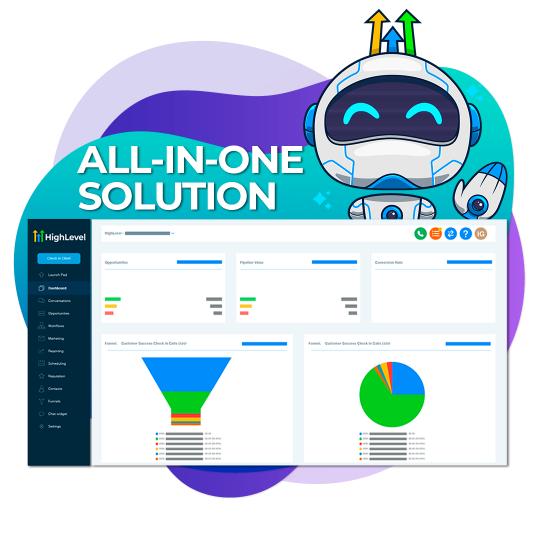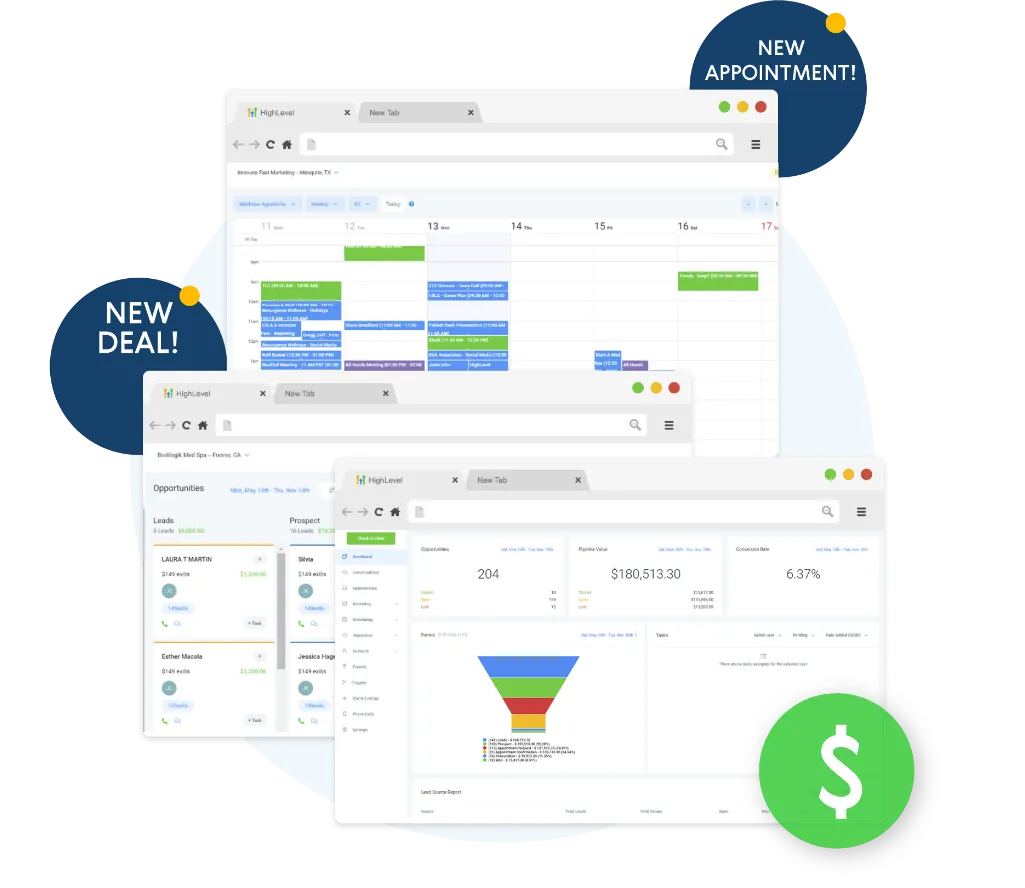We listen to what our customers tell us to help our business grow better. Our CRM tools make it easy to learn from feedback in many ways. We can send emails to ask questions, chat with customers, or get their thoughts while they use our service. When we look at what customers say, we can spot what needs to fix. Our smart tools sort the feedback so we know what to work on first. We can then send the right message to each customer to show we care. By keeping track of how happy customers are, we make things better for them. When we keep doing this over and over, our business keeps getting stronger. Let's see how to make the most of these tools to help both you and your customers.
Feeling overwhelmed by missed leads and disorganized workflows?
Discover the award-winning platform that automates follow-ups, tracks every lead, and keeps your business running smoothly—all in one place. Thousands of businesses are already transforming their sales and marketing with this trusted solution. Don’t miss out—start your 14-day free trial today and click now to uncover exclusive, limited-time special offers!
Understanding Customer Feedback Management

Listening to what customers say helps us make things better for them. When we hear their stories and ideas, we learn how to fix problems and make them happy.
We use simple tools to ask customers what they think. Our team reads all the answers and looks for ways to help. We sort the feedback by what people like and don't like.
We also look at who our customers are and what they buy to give them just what they need. Most customers want us to pay attention to what they say and make changes.
CRM Feedback Collection Methods
We listen to what customers tell us in many ways. This helps us understand what they like and what they need.
We send quick questions by email that customers can answer. They tell us if they're happy or not.
When people use our app, they can tell us right away if something is good or bad. They can also chat with us live.
We sit down and talk with customers face to face. This lets us hear their full story and learn how to help them better.
Our smart tools look at all this feedback. They show us what many customers are saying so we can fix problems fast.
Ready to simplify your business operations?
Streamline your workflows and boost productivity with a CRM designed to save you time and effort. From tracking leads to automating follow-ups, this platform does it all. Discover what’s possible—learn more about how it works and see why so many businesses rely on it every day.
Data Integration Best Practices

We want to help your team work better with customer feedback.
Let's make sure all your tools can talk to each other. Think of it like building bridges between different islands of information.
Keep your data clean and easy to read. Check it often to make sure it's right.
When one tool gets new info, the others should know right away. This helps your team see what customers say and take quick action.
The faster you can use this info, the better you can help your customers grow.
Seamless System Connectivity
Connecting your business systems helps you serve customers better. Simple tools make everything work together smoothly.
Think of it like building blocks that snap together:
- Special tools move your data between systems right away
- Ready-to-use links make your daily work easier
- Strong locks keep customer details safe
- Keeping watch helps catch any mix-ups fast
The tools work in the background, like a helpful friend making sure all parts of your business talk to each other.
When systems work as one, you can focus on what matters most – your customers.
Data Quality Management
Your CRM needs clean, good data to work well. Think of data like building blocks – you want the best ones to build something strong.
First, pick what you want to do with your data. Make it match what your business needs.
Make sure your data is right before you start using it. Clean it up and put it in order. Pick tools that work well with what you already use.
Keep your data safe too – just like you lock your house, lock up your customer info. Bad people shouldn't get it.
Check your data often to make sure it stays good. Test it like you'd test a car to make sure it runs well.
When you do this, your CRM will help your team do better work.
Real-Time Information Flow
Real-time data helps you help your customers better. When your team can see fresh info right away, they can do their jobs better.
You need good tools to make this work:
- Link all your data so it shows up fast
- Mix old and new info to see what might happen next
- Help customers right away with quick answers
- Keep your data clean by checking it often
When your data moves fast between all your tools, you can:
- Fix problems before they get big
- Make smart choices
- Give better help to customers
- Know what's happening right now
This means you always have the newest info to work with. Your team can jump in and help customers without waiting for updates.
Fresh data means happy customers.
Still struggling to keep your business organized?
Take the guesswork out of managing leads and follow-ups with a platform trusted by thousands of businesses. Say goodbye to missed opportunities and hello to a seamless sales process. Act now—try it free for 14 days and discover how easy it is to stay on top of your workflow. Don’t wait—exclusive offers won’t last long!
Customer Response Analysis Tools
We use smart tools to understand how customers feel about our service. These tools read customer comments and show us if people are happy or upset. Think of it like a report card that shows how well we're doing.
The tools make simple charts and pictures that help us see what customers want. When lots of people mention the same problem, we can fix it fast. When people share good ideas, we can make things better for everyone.
The best part is that these tools do the hard work for us. They sort through all the comments and help us focus on what matters most. This way, we can spend more time helping customers and less time reading through notes.
Sentiment Tracking Made Simple
We want to help you understand what your customers think and feel. Three simple tools make this easy.
These tools look at comments from social media, emails, and surveys all at once. They tell you right away if customers are happy or upset.
Tools like Qualtrics and SentiSum take customer words and show you what they mean. They also sort feedback into three groups:
- Happy customers
- Okay customers
- Unhappy customers
These tools can:
- Spot problems before they get big
- Show you feedback from many places at once
- Find patterns in what customers say
When you link these tools to your customer system, you can answer upset customers fast.
This helps turn random feedback into a clear plan to make things better.
Data Visualization Best Practices
Looking at what customers tell us helps us make things better. We can turn their words into pictures that show us what matters most. Think of it like drawing a story:
Bar charts show us what's bigger or smaller.
Line charts show us changes over time.
Maps show us where things happen.
Keep your pictures simple. Use just a few colors and big, clear words. Tools like Tableau and Power BI help make these pictures come alive on your screen.
Make all your pictures look the same way. Use the same writing style and keep them neat. Set up your computer to update the pictures when new information comes in.
When you look at these pictures, you can spot what's working and what's not. This helps you make smart choices based on real facts.
Automated Response Pattern Analysis
We use smart tools to understand what customers tell us. These tools help us know what customers need and want right now. When someone talks to us, our team can help them faster and better.
Our tools learn about people who might buy from us. They look at who these people are and what they do. This helps us know who needs our help the most.
As customers talk to us, we can see what they're saying right away. This means we can make smart choices fast.
Our tools can tell if customers are happy or upset. If someone isn't happy, we can help them quickly.
We learn more about our customers every day. This helps us give better service before problems start.
These tools help us make friends with our customers. They also help us work better and grow bigger.
Feedback Workflow Automation

Feedback automation helps businesses grow and keep customers happy. When you let computers handle feedback, you cut down on mistakes and work faster.
| Feature | Benefit | Impact |
|---|---|---|
| Automated Tasks | Less Manual Work | Works All Day |
| Quick Alerts | Fast Updates | Fast Action |
| Smart Rules | Better Processing | Same Results |
| Connected Systems | Easy Data Sharing | One Platform |
Want to make your customer system better? First, look for slow tasks that a computer can do. Then, make simple rules for these tasks. Test them to make sure they work well with your other tools. Keep checking how well they work and fix any problems. This will help you take better care of your customers.
Struggling to keep up with your growing business?
Simplify your processes and stay ahead with a CRM that adapts to your needs. Manage leads, automate tasks, and focus on what matters most—growing your business. Take the first step—explore the features today and see how it can transform the way you work.
Customer Satisfaction Metrics
Getting feedback from customers is easier with automated tools. But we need simple ways to know if customers are happy.
We can track how happy customers are by looking at:
- How they rate us from 1-5 after talking to us
- If they'd tell friends about us
- How easy it was for them to get help
- How fast we respond when they need help
These numbers help us see what we're doing well and where we need to do better.
When we know these things, we can make customers happier.
Strategic Data Segmentation

Getting to know your customers better is like sorting candies into different jars. Your CRM helps you put customer info into groups that make sense.
You can sort people in simple ways, like where they live or how old they are. You can also look at what they buy and how much they spend.
When you put this info in your CRM, you can see what each group needs and likes. As you learn more about your customers, you can send them messages they care about.
Keep watching how your groups work. This helps you give customers what they want and helps your business grow.
Action Plans From Feedback
Let's turn feedback from customers into real actions that help your business grow.
When you look at what customers tell you, you can spot patterns. These patterns show you what needs to fix first. Your team can then make these fixes step by step.
Keep asking customers what they think to see if your fixes worked. That way, you know you're making things better for them.
Transform Data Into Strategy
Let's turn your data into a clear plan that works. Think of it like sorting through puzzle pieces to make a picture.
First, look at what people tell you. Put their ideas into groups that make sense. This helps you see what matters most.
Your main tasks:
- Pick which changes you need now and which can wait
- Make sure your work helps your business grow
- Watch how things work as they happen
- Keep your information clean and up to date
Start with what'll help people the most. Set goals you can count. Check often to see if you're doing well. As your customers change what they want, change your plan too.
Remember to:
- Look at numbers that matter
- Fix problems fast
- Keep customer info safe
- Make choices based on facts
Pick the big wins first. Small steps add up to big changes. Watch what works and fix what doesn't.
Implement Change Successfully
Listen up! When customers tell us what they think, we need to act smart. First, pick out the most important feedback. Send it to the right people who can help fix things right away.
Make a simple list of what feedback needs quick action. This could be when many customers have the same problem, or when our best customers need help.
Look at why problems happen. Then make clear goals to fix them. Write down each step and who'll do what. Tell your team about any changes and what they need to do.
Keep track of how things are going. See if your fixes are working. If not, try something new until you get it right.
Personalization Through CRM

Making customers happy is all about treating them like real people. A CRM helps you get to know each person who buys from you.
Think of your CRM like a friend who remembers everything about the people you serve. It helps you:
- Send the right messages to the right people
- Know what help each person needs
- Write emails that feel personal
- Group people who like the same things
When you know more about your customers, you can give them what they want. Your CRM turns numbers and facts into ways to make people smile. It helps you talk to customers like you'd talk to a friend.
The more you use your CRM to learn about people, the better you can help them. This makes them want to keep coming back to you.
Measuring Feedback Implementation Success
We watch how well our team helps customers every day.
We look at simple things, like how fast we answer questions and if customers are happy. We also check if we can fix problems the first time someone calls.
When customers give us ideas, we try them out and see if they work better.
We look at numbers that show us if more people buy from us and stay with us longer. This helps us learn what changes work best and how to keep getting better.
Track Measurable Improvements Daily
We need to check how things get better each day to help our customers.
Keep an eye on these things daily:
- Look at the data to fix mistakes right away
- See if your team is using the tools they should
- Ask customers if they're happy with our help
- Count how much time and money we save
When we track these things every day, we can:
- Fix problems fast
- Help customers better
- Show how well our work pays off
- Make smart choices about what to do next
Writing down what we learn each day helps us grow and serve people better.
It also shows us if the money we spend on tools is worth it.
All this work makes it easier to be friends with our customers and do a great job for them.
Monitor Response Time Metrics
We watch how fast we help our customers to give them better service. When we know how long people wait and how long it takes to help them, we can fix problems quickly.
Our team uses simple tools to see these numbers right away. We look at:
- How fast we say hello
- How long we talk to each person
- How many people are waiting
- Who's waited the longest
- How many people still need help
These numbers show us if our customers are happy and if we're doing a good job.
We use easy-to-read pictures to see how our team is doing. When something isn't right, we get a quick alert.
We set goals and look at old numbers to make sure we keep getting better. This helps us make friends with our customers and give them the best help we can.
Analyze Data-Driven Results
Looking at numbers helps us see if our work is helping. When we check our team data often, we find out what works and what does not. We want to focus on the numbers that help us grow.
We need to:
- See if people are using the new tools
- Check how many sales we make and how fast we make them
- Make sure our info is right
- See if the money we spend brings more money back
When we look at these numbers each week or month, we can fix problems fast. Pretty charts help everyone see how we're doing.
When the whole team can see the same numbers, we all work better together. Simple math tells us if we're going the right way. Our tools show us these numbers in ways that make sense.
When we use facts to make choices, our team wins.
Cross-Departmental Feedback Sharing

Feedback from customers helps us all work better together. When teams share what they learn from customers, everyone wins. A single system where we all can see customer needs makes teamwork easy.
Teams need simple ways to talk to each other about what customers say. Use big screens that show the same info to all teams at once. Set up ways for info to flow fast between groups. Give team members rewards when they share good feedback with others.
Real-Time Response Management
When you help customers right away, they become happier. A quick response system lets you fix problems fast and keep customers coming back.
To help customers better, do these things:
- Get alerts when you miss messages
- Use smart tools to know your customers better
- Change prices when the market changes
- Watch for new trends as they happen
Make sure your info is good and your team knows what to do.
When you help customers fast, you do better than other companies. You fix things faster and make fewer mistakes. This makes your customer service work better.
Customer Retention Through Feedback

Getting customers to stay starts with listening to them. When they tell you what they think, you can make things better for everyone.
Your tools help you see what makes customers happy or upset. This lets you fix problems fast, before people leave. You can send friendly notes to check in and show you care.
The more you learn about what each person likes, the better friend you can be to them. Just like making a new friend, you need to pay attention and remember what matters to them. This makes them feel special and want to stick around.
CRM Analytics for Growth
Your CRM helps you see what your customers want. Think of it as a tool that shows you the story behind the numbers.
With CRM data, you can:
- See how much money you make
- Know if customers are happy
- Find out which leads turn into sales
- Spot who might stop buying from you
- Learn who's ready to buy more
When you know these things, you can:
- Send the right message to the right people
- Make more money from your ads
- Fix problems in your sales
- Help your team work better
Look at how customers talk to you. See what they buy. Watch how they use social media.
When you share what you learn with your team, everyone can work together to make customers happy.
This simple way of using data helps your business grow. It takes the guesswork out of selling and shows you the best way forward.
Building Customer-Centric Solutions

We listen to what customers tell us to make things better. Our team turns customer ideas into real changes that help everyone.
Here's what we do with customer feedback:
| What We Get | What We Do |
|---|---|
| Survey Answers | Make service fit each customer |
| Social Media Posts | Talk to customers better |
| Help Desk Chats | Fix problems faster |
| Sales Records | Make products customers want |
| Staff Notes | Get teams to work together |
We take steps to grow by using what customers and workers tell us. We put all this info in one place to help us see what needs to change. When we make things easier for customers, our business does better.
Conclusion
Your CRM helps you listen to what customers say and make things better. When people tell you what they think, your tools gather all their ideas in one place. This helps you see what makes them happy or upset. You can then fix problems and make your service better. As you help more customers, they stay with you longer. Your business grows when you listen and act on what people say.








